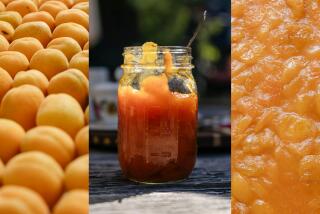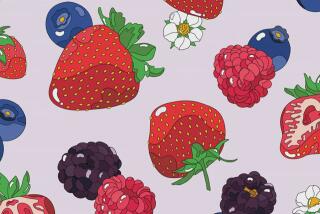Sweet Meat
- Share via
Dried fruit doesn’t get much respect in this country. Perhaps the only time you even think about it is now, the start of fruitcake season. Trail mix? It is what it is: a bag of nuts and dried fruit. Fuel for the body indeed--dried fruit has more concentrated nutrients, minerals and fiber than fresh fruit--but it’s mostly something you eat because it’s good for you.
In fact, dried fruit has a long and varied culinary history. Meat stews have been flavored with apricots, prunes, raisins and dates in much of the Arab and Persian world since the Middle Ages. Arab cooking, according to the Oxford Companion to Food, treated dried fruits much like vegetables--pairing apricots with lamb, for example. Persian cuisine is fond of mixing barberries into savory dishes. Even the English used dried fruits, because they were a cheaper sweetening agent than sugar. The fish pie chock-full of dried fruit, popular in the Middle Ages, hardly inspires revisiting, but who knows? However, meat pies were savored well into the 18th century and, laced with dried fruit, seemed more appealing. A rehydrated compote of dried fruit is still a staple of the English and, as I discovered recently, Australian breakfast.
But I’d never considered dried fruit as an addition to savory dishes until I visited Prague. This was in the mid-’90s, and to be charitable there was not a lot of good food available. I found myself in a restaurant whose specialty was, as I read it, the Sandra Bernhard. Weird. Bernhard’s humor must translate into Czech like a Swedish folk saying does into English. (“Don’t say hello before you jump over the water,” being an example posited by a Swedish friend.)
I questioned the waiter, who spoke some English. Was Bernhard popular in the Czech Republic? Had he ever seen her perform? “Dead,” he said. I told him she was alive. He insisted she was dead, and I again contradicted him. That made him mad. Obviously I was even dumber than most Americans. “French actress! Dead 70 years!” I reexamined the menu. A bad cold had fuzzed my vision, and I’d confused the long-gone French actress Sarah Bernhardt with our own homegrown diva.
Eventually Sarah Bernhardt arrived on a plate--beef roulade filled with dried fruit and nuts. I have no evidence that this was typical Czech cuisine--at one time both envied and emulated by Viennese gourmets--as the Czechs were still recovering from Soviet Satellite Syndrome. Anyway, the dish was delicious. Here I’d found a fresh marriage of savory and sweet, a nice change from the 4 gallons of Pilsener and 6 pounds of sausage I had been consuming daily.
*
Beef and Dried Fruit Stew
Serves 6 to 8
2 pounds beef chuck roast
2 tablespoons butter or oil
3 large carrots, peeled and sliced into 1/2-inch pieces
3 medium onions, thinly sliced
2 tablespoons flour
2 cloves garlic, crushed
1 teaspoon chopped fresh dill, or 1/2 teaspoon dried
1/2 teaspoon nutmeg, freshly grated or ground
Salt
Freshly ground black pepper
1 1/2 cups beef stock
1/2 cup dried medium apricots
1/2 cup dried peaches, quartered
1/2 cup pitted prunes
1 teaspoon chopped mint
1 tablespoon chopped cilantro
1/2 cup chopped walnuts
1/4 cup orange juice
Trim excess fat from the chuck roast and cut into large cubes. Heat a large, heavy skillet, add butter or oil and one-third of the beef cubes. Brown well over high heat and remove, browning the remaining beef in two batches. Set beef aside. Add sliced carrots and onions and saute until softened and the onions start to turn golden brown.
Return meat to skillet and sprinkle with flour. Add garlic, dill, nutmeg, salt, pepper and beef stock. Bring to a boil and stir. Cover, reduce heat to low and simmer for 1 1/2 hours. Add dried fruits, mint and cilantro. Cover and simmer 30 more minutes or until the meat is tender. Transfer to a warm serving dish. Sprinkle with walnuts and orange juice.
*
Martin Booe last wrote for the magazine about vanilla.


